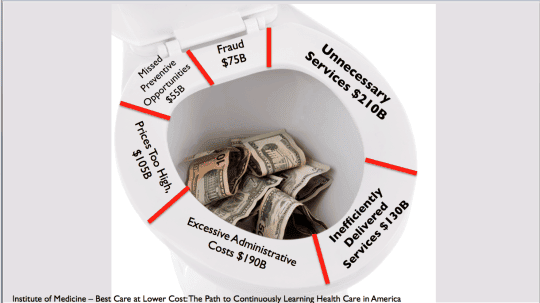As a reminder, I am giving a free Gemba Academy webinar tomorrow (Tuesday 3/12) on “Stories about the Eight Types of Waste in Healthcare.” Click here to learn more and sign up.
I'm going to tell some stories from my own work and other stories that have made the news about different forms of waste in healthcare. I think the most important type of waste is “Defects” — or process problems that harm patients. We have to focus on safety first, especially considering what a serious problem this is around the world.
Poor quality and safety leads to costs that are higher than they need to be. Below is my attempt at a creative pie chart (for the webinar) that shows the waste that's documented in the recent Institute of Medicine report that says we waste $765 billion a year in the U.S. (about one third of all healthcare spending that provides no value to patients). Version two of this graphic probably needs to involve the work of a graphics person…
[adrotate banner=”160″]
Please scroll down (or click) to post a comment. Connect with me on LinkedIn.
Let’s build a culture of continuous improvement and psychological safety—together. If you're a leader aiming for lasting change (not just more projects), I help organizations:
- Engage people at all levels in sustainable improvement
- Shift from fear of mistakes to learning from them
- Apply Lean thinking in practical, people-centered ways
Interested in coaching or a keynote talk? Let’s talk.
Join me for a Lean Healthcare Accelerator Trip to Japan! Learn More











Great graphic. Incredible waste. Just wish hospitals would see the burning platform. How can we get them to actually care about real change to reduce costs? The financial incentives don’t seem to be there.
Here is the recording of the webinar:
http://www.gembaacademy.com/webinars/graban-wastes.html
Mark,
You left off one of the most important areas and that is in the Supply Chain —>>Utilization Management or the management of the consumption of the products, services and technologies. You may have the best price, the most efficient inventory/replenishment systems but you still have to track after how the staff are utilizing the products. E.g., if the nurses are using too many IV Catheters then they may have proficiency issues with gaining the IV Site. If you negotiate a contract with the past use to use 3-5 exam gloves per patient day but when the new contract is implemented your staff now uses 5-8 then you have a consumption issue. This is the new realm of saving on supplies that is basically powdered snow in the healthcare supply chain as far as savings opportunities. Waste, misuse, product mismatches and feature rich products can cause more damage to a hospital’s bottom line and most organization’s don’t have a way to track it so it’s invisible. Total spend may not uncover the issues.
If I were a hospital administrator, I could care less about a few more gloves here and there when, on average, one patient per week is dying at your average hospital due to preventable medical errors and hospital acquired infections. The supply chain issues wouldn’t keep me up at night.
Interesting answer and I cannot disagree that lives are more important and I did point out a critical issue such as the IV Catheter proficiency which could result in IV Site infection issues.
With all due respect, your article was about waste in healthcare and flushing money down the toilet which I was added to your point in the article. You do realize that the average hospital uses over 3,000 to 30,000 products (depends on their size) and did you ever think that if they overuse a product that it could be the cause of something bigger like the IV Catheter Proficiency or using too many Foley Catheter’s could cause unwanted and unnecessary Urinary Tract Infections? Or changing out these products too often now opens up a closed system to infection because of more frequent turnover of the product.
We should save lives and control costs while maintaining or improving quality, they go hand in hand.
Yes this all goes hand in hand – lowering cost can lead to better quality and vice versa when we do things the right way (instead of focusing just on cost cutting).